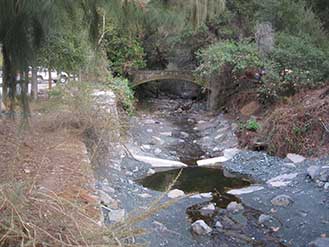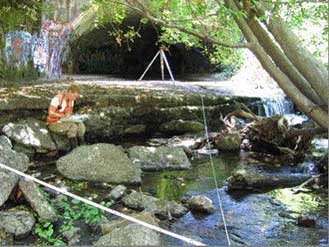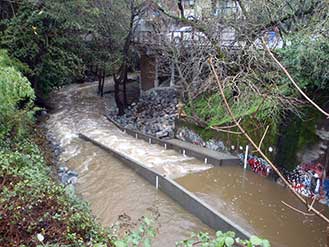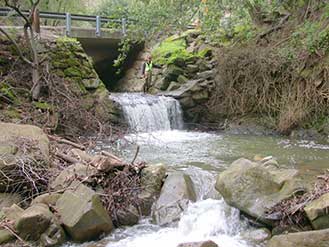What We Do >
Steelhead >
SF Bay Area >
Passage Improvement
Estuary Passage Improvement Program
The purpose of this program is to complete a vital step for the restoration of steelhead trout in the Bay Area's most important steelhead streams by removing barriers to upstream migration. Accomplishing this goal requires developing relationships with the owners of barriers and other interested stakeholders, conducting site studies to produce conceptual designs for the ecologically-preferred alternative and initial cost estimates, and then developing the financial and political support for final design, permitting, and construction.
CEMAR has worked since 2001 on developing barrier removal projects, and after over ten years of work we are pleased to see more and more of these critical barriers disappearing in the Bay Area. On this page you can see the results of our work in important steelhead streams including Alameda Creek,
Upper Penitencia Creek (a tributary of Coyote Creek),
San Francisquito Creek,
San Anselmo Creek (a tributary of Corte Madera Creek in Marin County),
Stuart Creek (a Sonoma Creek tributary),
Ritchie Creek (a tributary to the Napa River),and
Stonybrook Creek (an Alameda Creek tributary).
Major funding for the Estuary Passage Improvement Program has been provided by the California State Coastal Conservancy, the Bella Vista Foundation, the Giles W. and Elise Mead Foundation, American Rivers, and the Alameda County Resource Conservation District.
Penitencia Creek
In 2012, the City of San Jose completed modifications, based on CEMAR's analysis and conceptual designs, to a migration barrier in Upper Penitencia Creek near the Youth Science Institute in Alum Rock Park
 |
|
 |
Before:
View upstream at Alum Rock Park site, Upper Penitencia Creek,Coyote Creek watershed, Santa Clara County |
|
After:
Photo courtesy of Mike McClintock, Alum Rock Park |
return to top
San Anselmo Creek
Also in 2012, modifications were completed to a culvert on San Anselmo Creek (just below Center Boulevard). CEMAR's design recommendations included a series of raised baffles and step pools to slow streamflow and improve migrating conditions for fish on this tributary to Corte Madera Creek in Marin County.
 |
|
 |
Before:
View upstream at Landsdale site, San Anselmo Creek Corte Madera Creek watershed, Marin County |
|
After:
Photo courtesy of Sandy Guldman, Friends of Corte Madera Creek
|
return to top
Stuart Creek and Ritchie Creek
 |
|
Construction is expected to begin in the summer of 2014 to remove three manmade barriers on Stuart Creek in Glen Ellen. CEMAR, in collaboration with an engineering team, used a grant from the California Coastal Conservancy to develop an initial modification design for one of the barriers. The Sonoma Creek watershed once supported the second-largest steelhead trout run among Bay Area streams |
| View upstream at Stuart Creek Site Sonoma Creek watershed, Sonoma County |
|
|
| |
|
|
|
The Ritchie Creek project in Bothe-Napa Valley State Park has not yet been funded for final design and implementation although it remains one of the regionís highest passage priorities. |
|
 |
| |
|
View upstream at entrance road site, Ritchie Creek Napa River watershed, Napa County
|
return to top
San Francisquito Creek
 San Francisquito Creek post Bonde weir project San Francisquito Creek post Bonde weir project |
|
In 2013, a partnership of NGOs and government agencies completed an important restoration effort on San Francisquito Creek with the removal of the Bonde Weir. The 100-year-old concrete weir restricted creek flow and spawning habitat for migrating steelhead trout. CEMAR provided technical support to implement modifications to the weir. Collaborators in the redesign of the weir included San Mateo County Resource Conservation District and the National Oceanic and Atmospheric Administrationís Restoration Center. Other key participants included Acterra, the San Francisquito Joint Powers Authority, California Coastal Conservancy, and the U.S. Environmental Protection Agency. |
return to top
Stonybrook Creek
| With support from the Coastal Conservancy and American Rivers, CEMAR's team developed designs to modify two important fish passage barriers on Stonybrook Creek, a tributary of Alameda Creek known to be used by steelhead. The upstream barrier (see photo) will be replaced with a freespan bridge in a project led by the Alameda County Resource Conservation District and funded largely by the U.S. Environmental Protection Agency. |
|
 Stonybrook Creek at upstream passage barrier Stonybrook Creek at upstream passage barrier |
return to top
CEMAR: Center for Ecosystem Management and Restoration
Pursuing innovative, collaborative approaches to restore California's coastal ecosystems.
Email: questions "at" cemar "dot" org
|
